Module 14 lab - Study guides, Class notes & Summaries
Looking for the best study guides, study notes and summaries about Module 14 lab? On this page you'll find 422 study documents about Module 14 lab.
Page 2 out of 422 results
Sort by
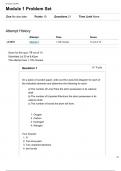
-
CHEM 219 Module 1 Problem Set Principles of Organic Chemistry with Lab Gallaher Portage Learning.
- Exam (elaborations) • 18 pages • 2024
- Available in package deal
-
- $11.99
- + learn more
CHEM 219 Module 1 Problem Set Principles of Organic Chemistry with Lab Gallaher Portage Learning. Score for this quiz: 10 out of 10 Submitted Jul 25 at 8:42pm This attempt took 1,135 minutes. Question 1 0 / 0 pts Your Answer: On a piece of scratch paper, write out the Lewis Dot Diagram for each of the indicated elements and determine the following for each: a) The number of Lone Pairs the atom possesses in its valence shell. b) The number of Unpaired Electrons the atom possesses in its...

-
CHEM 219 Module 1 Problem Set: Principles of Organic Chemistry with Lab FALL 2023 Portage learning
- Exam (elaborations) • 18 pages • 2023
-
- $22.49
- + learn more
On a piece of scratch paper, write out the Lewis Dot Diagram for each of the indicated elements and determine the following for each: a) The number of Lone Pairs the atom possesses in its valence shell. b) The number of Unpaired Electrons the atom possesses in its valence shell. c) The number of bonds the atom will form. 1. Oxygen 2. Carbon 3. Hydrogen 4. Nitrogen 1. O 2. Two lone pairs 3. Two unpaired electrons 4. two bonds 12/14/23, 8:42 PM Module 1 Problem Set: Principles of Or...
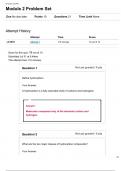
-
CHEM 219 Module 2 Problem Set Principles of Organic Chemistry with Lab Gallaher Portage Learning.
- Exam (elaborations) • 16 pages • 2024
- Available in package deal
-
- $11.99
- + learn more
CHEM 219 Module 2 Problem Set Principles of Organic Chemistry with Lab Gallaher Portage Learning. Score for this quiz: 10 out of 10 Submitted Jul 31 at 5:44pm This attempt took 110 minutes. Question 1 Not yet graded / 0 pts Your Answer: Define hydrocarbon. A hydrocarbon is a fully saturated chain of carbons and hydrogens Answer: Molecules composed only of the elements carbon and hydrogen. Question 2 Not yet graded / 0 pts Your Answer: What are the two major classes of hydrocarbon co...
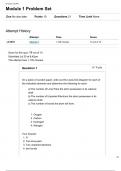
-
CHEM 219 Module 1 Problem Set Principles of Organic Chemistry with Lab Gallaher Portage Learning.
- Exam (elaborations) • 18 pages • 2024
- Available in package deal
-
- $12.99
- + learn more
CHEM 219 Module 1 Problem Set Principles of Organic Chemistry with Lab Gallaher Portage Learning. Score for this quiz: 10 out of 10 Submitted Jul 25 at 8:42pm This attempt took 1,135 minutes. Question 1 0 / 0 pts Your Answer: On a piece of scratch paper, write out the Lewis Dot Diagram for each of the indicated elements and determine the following for each: a) The number of Lone Pairs the atom possesses in its valence shell. b) The number of Unpaired Electrons the atom possesses in its...
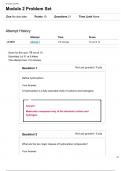
-
CHEM 219 Module 2 Problem Set Principles of Organic Chemistry with Lab Gallaher Portage Learning.
- Exam (elaborations) • 16 pages • 2024
- Available in package deal
-
- $12.99
- + learn more
CHEM 219 Module 2 Problem Set Principles of Organic Chemistry with Lab Gallaher Portage Learning. Score for this quiz: 10 out of 10 Submitted Jul 31 at 5:44pm This attempt took 110 minutes. Question 1 Not yet graded / 0 pts Your Answer: Define hydrocarbon. A hydrocarbon is a fully saturated chain of carbons and hydrogens Answer: Molecules composed only of the elements carbon and hydrogen. Question 2 Not yet graded / 0 pts Your Answer: What are the two major classes of hydrocarbon co...
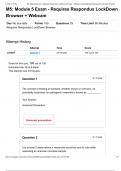
-
MICROBIOLOGY Module 5 Exam (Portage learning) 2023 The concept of treating all samples
- Exam (elaborations) • 17 pages • 2023
-
Available in package deal
-
- $19.49
- + learn more
The concept of treating all samples, whether known or unknown, as potentially hazardous (or pathogenic) materials is known as __________. Universal Precaution Universal precautions Ques 3 / 3 pts tion 2 List at least 3 observations a researcher would be sure to note while assessing an unknown microbial sample. 5/1/22, 6:14 PM M5: Module 5 Exam - Requires Respondus LockDown Browser + Webcam: Essential Microbiology with Lab-2021-Bowman Your Answer: Three observations are; The Gram statu...
BIOD 7-1 MasteringA&P Lab: Module Seven Homework Chapter 14 Chapter Test Question 3
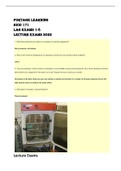
-
Portage Learning BIOD 171 Lab Exams 1-8 Lecture Exams 2022
- Exam (elaborations) • 19 pages • 2022
-
- $19.49
- 2x sold
- + learn more
Portage Learning BIOD 171 Lab Exams 1-8 Lecture Exams 2022 Lecture Exams 1. What three elements are used in an autoclave to sterilize equipment? heat, pressure, and steam 2. What is the minimum temperature an autoclave must be set at to achieve sterile condition? 125°C 3. If you are working in a lab in which an autoclave is not available, and you are pressed for time, which would you chose to best sterilize your equipment? Hot steam or hot air? Explain why you chose your answer. ...

-
Module 8 Portage 219 Organic Chemistry Exam with Answers Graded A+
- Exam (elaborations) • 14 pages • 2024
-
- $10.99
- + learn more
1 / 14 Module 8 Portage 219 Organic Chemistry Exam with Answers Graded A+ 1. Polymer large molecule made by repetitive linking of smaller units (monomers) 2. Macromolecule very large molecule composed of thousands of covalently bonded atoms (ex: polymer) 3. 1. natural (in nature) 2. synthetic (in lab) 4. rubber, carbs: starch & cellu- lose, proteins, nucleic acids DNA, RNA 5. nylon, teflon, styrofoam, poly- ethylene, Dacron, 6. 1. method of formation 2. final composition 3. stereo...
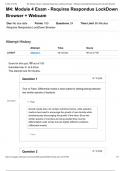
-
MICROBIOLOGY Module 4 Exam (Portage learning) True or False: Differential media
- Exam (elaborations) • 13 pages • 2023
-
Available in package deal
-
- $19.49
- + learn more
True or False: Differential media is best suited for distinguishing between two similar species of bacteria. True Correct! Growth media does not contain restrictive factors, while selective media is best used to encourage the growth of one microbe while simultaneously discouraging the growth of the other. Since two similar species of microbes are being studied they must be differentiated under similar but just slightly different conditions (differential media). False Q 2 / 2 pts uestio...

$6.50 for your textbook summary multiplied by 100 fellow students... Do the math: that's a lot of money! Don't be a thief of your own wallet and start uploading yours now. Discover all about earning on Stuvia



